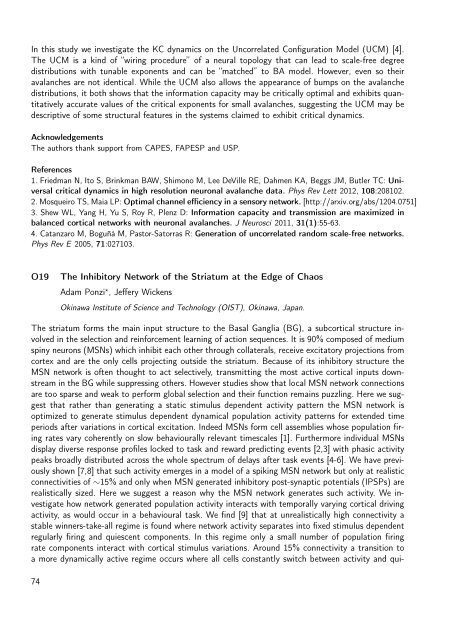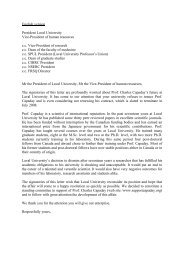Untitled - Laboratory of Neurophysics and Physiology
Untitled - Laboratory of Neurophysics and Physiology
Untitled - Laboratory of Neurophysics and Physiology
Create successful ePaper yourself
Turn your PDF publications into a flip-book with our unique Google optimized e-Paper software.
In this study we investigate the KC dynamics on the Uncorrelated Configuration Model (UCM) [4].<br />
The UCM is a kind <strong>of</strong> “wiring procedure” <strong>of</strong> a neural topology that can lead to scale-free degree<br />
distributions with tunable exponents <strong>and</strong> can be “matched” to BA model. However, even so their<br />
avalanches are not identical. While the UCM also allows the appearance <strong>of</strong> bumps on the avalanche<br />
distributions, it both shows that the information capacity may be critically optimal <strong>and</strong> exhibits quantitatively<br />
accurate values <strong>of</strong> the critical exponents for small avalanches, suggesting the UCM may be<br />
descriptive <strong>of</strong> some structural features in the systems claimed to exhibit critical dynamics.<br />
Acknowledgements<br />
The authors thank support from CAPES, FAPESP <strong>and</strong> USP.<br />
References<br />
1. Friedman N, Ito S, Brinkman BAW, Shimono M, Lee DeVille RE, Dahmen KA, Beggs JM, Butler TC: Universal<br />
critical dynamics in high resolution neuronal avalanche data. Phys Rev Lett 2012, 108:208102.<br />
2. Mosqueiro TS, Maia LP: Optimal channel efficiency in a sensory network. [http://arxiv.org/abs/1204.0751]<br />
3. Shew WL, Yang H, Yu S, Roy R, Plenz D: Information capacity <strong>and</strong> transmission are maximized in<br />
balanced cortical networks with neuronal avalanches. J Neurosci 2011, 31(1):55-63.<br />
4. Catanzaro M, Boguñá M, Pastor-Satorras R: Generation <strong>of</strong> uncorrelated r<strong>and</strong>om scale-free networks.<br />
Phys Rev E 2005, 71:027103.<br />
O19<br />
The Inhibitory Network <strong>of</strong> the Striatum at the Edge <strong>of</strong> Chaos<br />
Adam Ponzi ⋆ , Jeffery Wickens<br />
Okinawa Institute <strong>of</strong> Science <strong>and</strong> Technology (OIST), Okinawa, Japan.<br />
The striatum forms the main input structure to the Basal Ganglia (BG), a subcortical structure involved<br />
in the selection <strong>and</strong> reinforcement learning <strong>of</strong> action sequences. It is 90% composed <strong>of</strong> medium<br />
spiny neurons (MSNs) which inhibit each other through collaterals, receive excitatory projections from<br />
cortex <strong>and</strong> are the only cells projecting outside the striatum. Because <strong>of</strong> its inhibitory structure the<br />
MSN network is <strong>of</strong>ten thought to act selectively, transmitting the most active cortical inputs downstream<br />
in the BG while suppressing others. However studies show that local MSN network connections<br />
are too sparse <strong>and</strong> weak to perform global selection <strong>and</strong> their function remains puzzling. Here we suggest<br />
that rather than generating a static stimulus dependent activity pattern the MSN network is<br />
optimized to generate stimulus dependent dynamical population activity patterns for extended time<br />
periods after variations in cortical excitation. Indeed MSNs form cell assemblies whose population firing<br />
rates vary coherently on slow behaviourally relevant timescales [1]. Furthermore individual MSNs<br />
display diverse response pr<strong>of</strong>iles locked to task <strong>and</strong> reward predicting events [2,3] with phasic activity<br />
peaks broadly distributed across the whole spectrum <strong>of</strong> delays after task events [4-6]. We have previously<br />
shown [7,8] that such activity emerges in a model <strong>of</strong> a spiking MSN network but only at realistic<br />
connectivities <strong>of</strong> ∼15% <strong>and</strong> only when MSN generated inhibitory post-synaptic potentials (IPSPs) are<br />
realistically sized. Here we suggest a reason why the MSN network generates such activity. We investigate<br />
how network generated population activity interacts with temporally varying cortical driving<br />
activity, as would occur in a behavioural task. We find [9] that at unrealistically high connectivity a<br />
stable winners-take-all regime is found where network activity separates into fixed stimulus dependent<br />
regularly firing <strong>and</strong> quiescent components. In this regime only a small number <strong>of</strong> population firing<br />
rate components interact with cortical stimulus variations. Around 15% connectivity a transition to<br />
a more dynamically active regime occurs where all cells constantly switch between activity <strong>and</strong> qui-<br />
74



